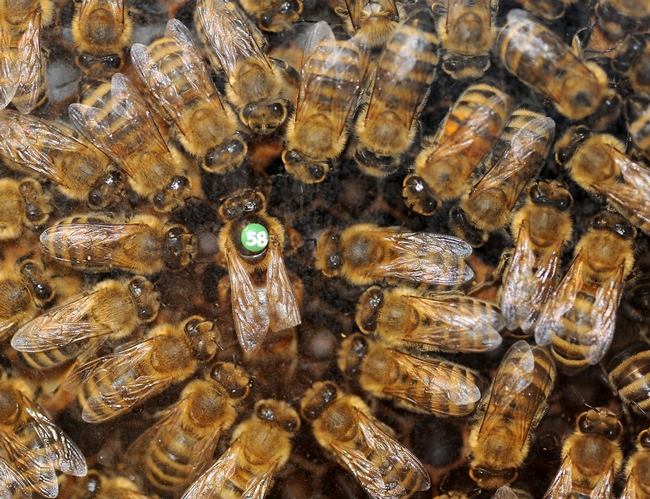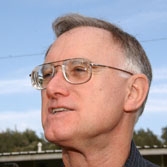Posts Tagged: Jr.
So, you want to be a commercial beekeeper...
So you want to be a full-time commercial beekeeper and keep 1,000 colonies or more.
Perhaps you want to sell honey and beeswax, rent your bees for commercial crop pollination, rear queen bees, or sell bulk bees.
The newly published second edition of the Small Farm Handbook, which draws on the knowledge of 32 experts from the University of California, contains a wealth of information. The chapter, "Raising Animals," covers beekeeping as a business.
“Costs to start a beekeeping business are not particularly high compared to many small businesses, and a well-planned and managed operation can be profitable,” writes Eric Mussen, Extension apiculturist with the UC Davis Department of Entomology.
“Beekeepers own, rent or find rent-free apiary locations where their bees can forage for food without becoming a nuisance to humans or livestock. Beekeepers must manage their colonies to the benefit of the bees and in compliance with existing state, county and municipal ordinances.”
For those who want to rent bees for pollination, “rental rates are as much as 10 times higher for almond orchards, which need to be pollinated a time of year when bee supplies barely meet demand.”
Indeed, California has some 750,000 acres of almonds, and each acre needs two colonies for pollination. Since the Golden State doesn't have that many bees, they are trucked in from all over the country.
"Fifty percent of the bees in the United States have to be in California to pollinate the almonds," molecular biologist and biochemist Joseph DeRisi of UC San Francisco said Jan. 9 at his lecture in the Genome and Biomedical Sciences Facility at UC Davis.
DeRisi, a Howard Hughes Medical Institute investigator and professor and vice chair of the Department of Biochemistry and Biophysics at UCSF, pointed out that “California supplies 80 percent of the world's almond supply.”
No bees, no almonds.
“Beekeeping can sound deceptively simple,” Mussen writes in the chapter, “but in fact beekeeping is a form of animal husbandry that involves providing feed when nectar and pollens are lacking, preventing infections from various microbes, dealing with two well-established parasitic mites, and reducing the influence of Africanized bees. Before you try to keep bees commercially on your own, you should gain experience working with a commercial beekeeper for one or more seasons.”
The latest parasite discovered in bees is the parasitic phorid fly (Apocephalus borealis). In work published Jan. 3 in the Public Library of Science (PLoS One) journal, San Francisco State University researchers wrote that the parasitic fly lays its eggs in the honey bees; it was previously known to parasitize bumble bees, but not honey bees.
The fly-infested bees display altered bee behavior. Nicknamed “zombie bees,” the bees fly at night toward lights, such as porch, building or street lights. They do not return to the hive; they die.
Neither Mussen nor DeRisi believes that the parasitic fly is a dominant factor in colony collapse disorder, a mysterious phenomenon characterized by adult bees abandoning the hive.
For tips on beekeeping, be sure to check out Mussen's bimonthly newsletter, from the UC Apiaries, and his other resource, Bee Briefs, both posted on the UC Davis Department of Entomology website.
And if you want to become an full-time commercial beekeeper, read the “Estimated Investment Needed for a 1,000-Colony Bee Operation” in the Small Farm Handbook.

Honey bee heading for almond blossoms, spring of 2011, at the Harry H. Laidlaw Jr. Honey Bee Research Facility, UC Davis. (Photo by Kathy Keatley Garvey)

The queen and her court at the Harry H. Laidlaw Jr. Honey Bee Research Facility, UC Davis. (Photo by Kathy Keatley Garvey)
That liquid gold called honey
If those pollen-packing honey bees were to board an aircraft, they’d be charged for their carry-on luggage.
Fortunately they don’t and they’re not.
And if we were a bee, we’d have to visit two million flowers to make a pound of honey.
Fortunately we’re not, and we don’t.
The honey bee, brought to America by the European colonists in the 1600s, will be celebrated on National Honey Bee Awareness Day, Saturday, Aug. 21, but this insect should be celebrated every day of the year.
Revered for her indispensable pollination services, she also provides us with that liquid gold we call honey. Wonderful, delectable, soothing honey.
“Honey is nature’s miraculous food,” write Ron Fessenden and Mike McInnes, co-authors of the 215-page book, Honey Revolution: Restoring the Health of Future Generations.
“The nutritional composition of honey, calorie for calorie, is closer to fruit than it is to table sugar, high fructose corn syrup or any other sweetener."
They call it “sunshine energy” and “nature’s soul food.”
Over at the Harry H. Laidlaw Jr. Honey Bee Research Facility, University of California, Davis, pop. 6 million (honey bees, that is), the faculty and staff call this insect simply “amazing.”
This week the UC Davis beekeepers are extracting honey — uncapping the combs with an electric knife, spinning the frames through the centrifugal-force honey extractor, and then gathering the flow of honey.
“It’s a sticky situation,” agreed staff research associate Elizabeth Frost, as Bryce Sullivan, a UC Davis senior majoring in biochemical engineering, and Brandon Seminatore, a UC Davis junior majoring in biochemistry and molecular biology, extracted honey — amid a few bee escapees.
The finished product is perfect for pouring on pancakes and waffles. The National Honor Board provided these recipes that kids of all ages love:
Honey Raspberry Citrus Slush
1-1/2 cups fresh orange juice
1/2 cup honey
2 tablespoons lemon juice
2 tablespoons lime juice
1-1/2 cups raspberries, fresh or frozen
1 cup crushed ice
Lemon or lime for garnish
In a blender, combine orange juice, honey, lemon and lime juices; mix until honey is dissolved. Add raspberries and ice; puree. Serve in beverage glasses garnished with a lemon or lime wheel. Makes six six-ounce servings.
Fruity Honey Yogurt Pops
1 cup fresh nectarines, pineapple or strawberries, chopped
1-1/2 cups plain yogurt
1/3 cup of honey
1 teaspoon vanilla
Eight 3-ounce paper cups and popsicle sticks or plastic spoons
In a blender, combine all ingredients; mix well. Pour evenly into eight paper cups; insert popsicle stick or plastic spoon in center of each. Freeze 4 hours or until frozen solid. Makes 8 pops.

Frame of Uncapped Honey

Sampling
Show me the honey
When the grand opening celebration of the Häagen-Dazs Honey Bee Haven at the University of California, Davis, takes place on Saturday, Sept. 11 from 10 a.m. to 2 p.m., this will also be a celebration of the honey bee.
The declining bee population, exacerbated by the mysterious disease called colony collapse disorder, makes us appreciate bees all the more. One-third of the food we eat is pollinated by bees.
Enter the Häagen-Dazs Honey Bee Haven.
Planted last fall next to the Harry H. Laidlaw Jr. Honey Bee Research Facility on Bee Biology Road, the honey bee haven is a half-acre bee friendly garden designed to provide a year-around food source for bees, increase awareness of the plight of the honey bee, and offer educational experiences for human visitors.
Visitors can learn the importance of honey bees and glean ideas on what to plant in their own gardens to attract bees and other pollinators. Here’s the award-winning design created by a Sausalito team. (Be sure to check out the Häagen-Dazs educational website.)
At the Sept. 11 grand opening, visitors also will gain a deeper appreciation of honey, sometimes called “the soul of a field of flowers.” Honey tasting, coordinated by Extension apiculturist Eric Mussen, member of the UC Davis Department of Entomology, is scheduled to be one of the activities at the celebration.
Of the more than 300 unique types of honey produced in the United States, among the most common floral sources are alfalfa, avocado, basswood, buckwheat, clover, eucalyptus, fireweed, orange blossom, safflower sages and tupelo.
A single bee can collect about 1/2 teaspoon of honey in her lifetime. To make a pound of honey, 560 worker bees must gather nectar from two million flowers, and fly a total of about 55,000 miles.
Like to cook with honey? Here are some recipes provided by the National Honey Board.
Applesauce Cake
1/2 cup butter, softened
1 cup honey
1 egg
1 teaspoon vanilla
1-1/4 cups all-purpose flour
1 cup whole wheat flour
1 teaspoon baking soda
?1 teaspoon ground cinnamon
1/2 teaspoon salt
1/2 teaspoon ground nutmeg
1/4 teaspoon ground cloves
1/4 teaspoon ground allspice or ginger
1 cup chopped dates
1/3 cup chopped walnuts
1 cup unsweetened applesauce
Cream butter in large bowl. Gradually beat in honey until light and fluffy. Add egg and vanilla; mix well. Combine dry ingredients in medium bowl; reserve 2 tablespoons flour mixture. Combine dates, walnuts and reserved 2 tablespoons flour mixture in small bowl; set aside. Add remaining flour mixture and applesauce alternately to creamed mixture, beginning and ending with flour mixture. Stir in date mixture. Pour batter into greased 13 x 9 x 2-inch pan. Bake at 325 degrees F for 35 minutes or until wooden pick inserted near center comes out clean.
Cranberry Oat Bread
3/4 cup honey
1/3 cup vegetable oil
2 eggs
1/2 cup milk
2-1/2 cups all-purpose flour
1 cup quick-cooking rolled oats
1 teaspoon baking soda?
1 teaspoon baking powder
1/2 teaspoon salt
1/2 teaspoon ground cinnamon
2 cups fresh or frozen cranberries
1 cup chopped nuts
Combine honey, oil, eggs and milk in large bowl; mix well. Combine flour, oats, baking soda, baking powder, salt and cinnamon in medium bowl; mix well. Stir into honey mixture. Fold in cranberries and nuts. Spoon into two 8-1/2 x 4-1/2 x 2-1/2-inch greased and floured loaf pans.
Bake in preheated 350 degrees oven 40 to 45 minutes or until wooden toothpick inserted near center comes out clean. Cool in pans on wire racks 15 minutes. Remove from pans; cool completely on wire racks. Makes 2 loaves.
Golden Cornbread
3 cups yellow cornmeal
1 cup whole wheat flour
2 tablespoons baking powder
1 teaspoon salt
2 cups buttermilk or low-fat yogurt
1/2 cup butter, melted
1/2 cup honey
3 eggs, beaten
Combine cornmeal, flour, baking powder and salt in large bowl. Combine buttermilk, butter, honey and eggs in separate large bowl. Stir buttermilk mixture into flour mixture just until moistened. Pour into greased 12x8x2-inch baking pan. Bake at 350 degrees for 25 minutes or until golden brown. Serves 8.

Honey Bee

The Beekeepers



